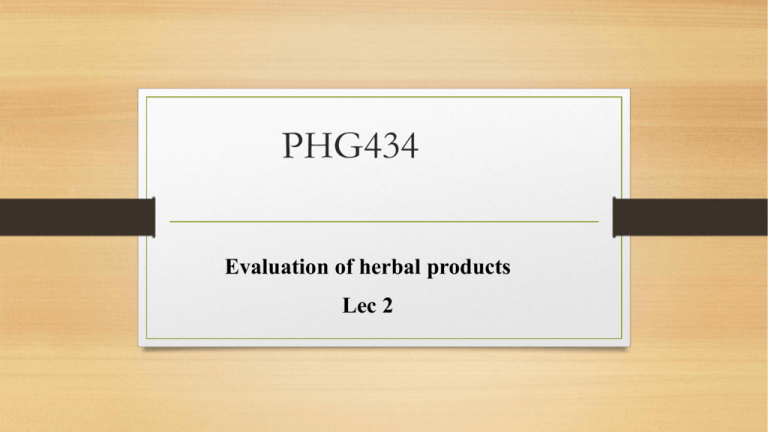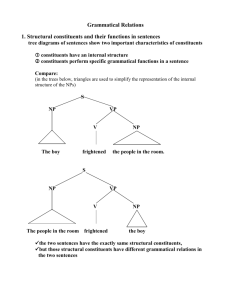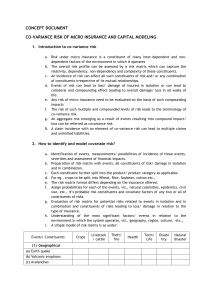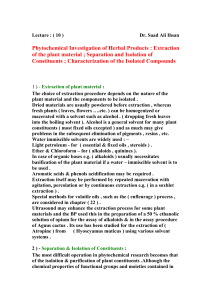File
advertisement

PHG434 Evaluation of herbal products Lec 2 If closely related species are leaves: We need to Ratio value: (Microscopical quantitative value) 1- Palisade ratio. 2- Stomata index. 3- Vein islet number. 4- Vein islet terminate number 1- Palisade ratio : Def: numbers of palisade cell under one epidermal cell using four continuous epidermal cells for the count. To do the ratio value is determined by “camera lucida” can transfer the microscopic field to microscopic stage by using mirror. Surface preparation: Take leave, T.S., count and draw 4 epidermal cells, then count and draw palisade cells under 4 epidermal cells. Palisade 2- Stomata index (%) المعامل الثغري: Def: it is the percentage of the number of stomata to the total number of epidermal cells, each stomata being counted as one cell. Stomatal index= S/E+S x 100 (S) Number of stomata per unit area (E) Number of epidermal cells in the same unit area. Cassia angustifolia (both surface) 17.1-18.7-20 Cassia acutifolia (both surface) 11.4- 12.2-13 Xylopia aethiopica Cassia acutifolia Cassia angustifolia Determination of stomatal numbers: It is an average number of stomata per mm2 of epidermis. Stomatal number Plant Upper surface Lower surface Atropa belladonna 7.5-10-17.5 77.5-113-176.5 Atropa acuminate 6-14-37.5 62.5-93-174 3- Vein islet number : Def. of vein islet: The small areas of green tissue outlined by the veinlets are temrmed vein islet. Def. of vein islet number: is the number of vein islet per mm2. Cassia angustifolia 25-30 Cassia acutifolia 19-23 4- Vein islet terminate number : Def: it is the number of veinlet termination per mm2 of leaf surface. A veinlet termination is the ultimate free termination of a veinlet or branch of a vienlet. It can be used to distinguish between leaves of closely related species. * Atropa belladonna 6.3-10.3 * Digitalis purpurea 2.5-4.2 * Hyoscymus niger 12.4-19.0 This value has been shown to be constant for any species and unaffected by the age of the plant or the size of the leaves. How to determined the mm2 ? By using Eye-piece micrometer and stage micrometer. Veins Chemical evaluation Most of drugs have definite chemical constituents to which their biological or pharmacological activity is attributed. Qualitative chemical test are used to identify certain drug or to test their purity. The isolation, purification, identification of active constituents is based on chemical methods of evaluation. Qualitative chemical test such as acid value, saponification value etc. Some of these are useful in evaluation of resins (acid value, sulphated ash), balsams (acid value, saponification value), volatile oils (acetyl and ester values) and gums (methoxy determination and volatile acidity). Preliminary phytochemical screening is a part of chemical evaluation. These qualitative chemical tests are useful in identification of chemical constituents and detection of adulteration. It is the study of active constituents by the application of chemical and physical methods to small quantities (a few milligrams) of the drug in powdered form or to histologic sections of the drug. It offers a means by which constituents of many drugs may be isolated and purified. It includes steps: I- Isolation of active constituents : A- By chemical solvents: 1- Micro-extraction 2- Micro-filtration 3- Micro-crystallization B- By micro-sublimation II- Identification of constituents: 1- By crystallography 2- By melting point determination 3- By confirmative test 1- Chemical test. 2- Physical test Micro-extraction: Def: It is a separation of the constituents from a small quantity of the drug and depends on the solubility of the constituents in a solvent. During micro-extraction procedures, various factors must be considered, such as: 1- State of division of the drug (whole, broken, powdered) 2- Type of solvent used with increase polarity [Pet. ether, chloroform, ethyl acetate, butanol, ethanol, methanol, water]. 3- Temperature: [increase temperature lead to increase solubility between solvent and extract]. 4- Nature of impurities e.g., if impurities soluble in certain solvent do not used this solvent. 5- Nature of substances e.g., volatile oil, fixed oil, sterol, triterpenes, anthracene, coumarin, flavonoids, alkaloids, . · If soluble in polar solvent means it is a polar compounds. · If soluble in non-polar solvent means it is a non-polar compounds. · All substances soluble in 90-95% alcohol. To secure small quantities of the extracted substances in a clear solution generally requires microfiltration methods to obtain the extracted constituent in a pure form necessitates crystallization and re-crystallization. Micro-crystallization: To obtain the extracted constituent in a pure form necessitates crystallization and recrystallization Micro-sublimation: 1- It is refer to a method of obtaining a constituent of a drug by heating the drug to vaporize its chief constituent to a gaseous state and then condensing the vapor back into a solid form. 2- This method is employed only when the drug or its constituents are not decomposed by heat. 3- When the constituent condenses on a cool place, the resulting crystals develop in a pure form. 4- Caffeine is sublimed from powdered Kola or from powdered coffee. II- Identification of constituents: 1- By crystallography: It is a science dealing with: i- Classification of crystals ii- Form iii- Structure iv- Properties of crystals e.g., crystal is: · Isotropic · Anisotropic · Uniaxial · Biaxial · Its type of extinction · Optic sign · Sign of elongation · Refractory index 2- By melting point determination: It is very important as a means of identifying pure substances. 3- By confirmative test: 1- Chemical test. 2- Physical test e.g., menthol is isolated from peppermint oil. It occurs as colorless, hexagonal crystals, usually needle like. The melting point of l-menthol from natural sources is between 41 and 43 ˚C. The use of the petrographic microscope is very important in the determination of the optic constants of crystalline substances. It is a rapid method for identification of very small amounts of chemical compounds. Before a new product is introduced on the market, it must be proven both safe and effective in preliminary pharmacologic tests on animals and in quantitative clinical tests on humans. Preliminary chemical test for active constituents: Qualitative test: 1- Test for glycosides and carbohydrate: * The test reaction is based on positive reaction to Molisch’s and Fehling’s reagents (after hydrolysis) which are not specific: * Powdered (the powdered extract with 2% alcohol, evaporate, dissolve in water) + Few drops of α-naphthol + conc H2SO4 → violet ring at the junction. * powdered + aniline citrate → brown color with reducing sugar (after hydrolysis). 2- Test for cardiac glycosides: The powdered extract with 70% alcohol, evaporate, dissolve in water and purified by lead acetate then tested for cardenolides by Baljet’s reagent, Raymond’s Kedde’s reagent or legal’s test. Test for deoxy sugar by keller killiani’s test is important for detection of glycosides containing this type of sugar. 3- Test for anthraquinone glycosides: The powdered drug is boiled either by dilute acid, by alcohol or by acid and oxidixing agent according to anthracene glycoside then the aglycones are extracted by organic solvent followed by addition of alkali give red color. 4- Test for flavonoids: The powdered is refluxed with alcohol, evaporate, the residue is extracted with boiling water and filtrate while hot. A portion of filtrate Is tested with different reagents, Ammonium hydroxide, ferric chloride. 5- Test for saponine: a- The powdered drug is extracted with 25% ethanol and filtrated. The filtrate is evaporated to dryness. The residue is dissolved in normal saline solution and added to a suspension of R.B.Cs in normal saline, if haemolysis occurs this indicates the presence of saponins in the drug. b- Famous forth test with water. 6- Test for tannins: The powdered drug is extracted with 50% ethanol and filtrated. The filtrate is tested for tannins Tannins + FeCl3→ blue color (hydrolysable tannins) ↓ Green color (condensed tannins) 7- Test for alkaloids: The alkaloid should be separated from other non alkaloidal material and impurity. How? a- The alkaline nature of alkaloids have an ability to form salts with acids. b- The relative solubility of free alkaloids and their salts in organic solvents and water. c- Most common reagent is used for testing alkaloids by precipitation or microcrystal are: Kraut’s, Mayer’s, Wagner’s. Physical evaluation Physical constants are sometimes taken into consideration to evaluate certain drugs. These include moisture content, specific gravity, optical rotation, refractive, melting point, viscosity and solubility in different solvents. All these physical properties are useful in identification and detection of constituents present in plant. Physical evaluation The application of physical constants is applied to the active principles of drugs such as alkaloids, volatile oils, fixed oil… etc. 1- Solubility: -We should determine solubility of active principles in different solvents. - Usually expressed in the following form: 1g is soluble in ….ml of water, … ml of alcohol, etc. e.g., 1g of atropine sulfate dissolves in 0.5ml of water, in 5 ml of alcohol and 2.5 ml of glycerin. 2- Specific gravity: - Particularly of the fats and volatile oils. - Weight of a given volume of liquid compared with the weight of equal volume of water at specific temperature in air. The specific gravity of anise oil is not less than 0.978 and not more than 0.988. Specific gravity of water =1 Most of V.O. is lighter than water, except V.O. of clove, cinnamon (heavier than water). Specific gravity is not absolutely constant………….why? Because other factors affected it: 1- maturity of drug from which v.o. is prepared. 2- Age of v. o. 3- Method of preparation. 4- Purification. 3- Optical rotation: Of certain alkaloids in solutions and of v. os. Described as dextro (+) rotary (rotate plane of polarized light to right, it is clock wise rotation). Or levo (-) rotary. rotate plane of polarized light to left, it is anti-clock wise rotation). . It is measured by polarimeter. Atropine ± zero Pelocarpine + Iso pelocarpine The angular rotation of peppermint oil is not less than -18◦ and not more than -32◦ in a 100 mm tube. Automatic Digital Polarimeter, range ±45°. Polarimeter cell 100 mm, 200 mm and a sodium lamp. Hand-Held Polarimeter, wave length 589nm, measurement range -35°… +35° optical rotation. 4- Refractive index: - Particularly of the fixed and volatile oils (crystals, liquids). It is a ratio of sign angle of incidence/sign angle of refraction of monochromatic beam. RI measure by refractometer. - The RI of peppermint oil is not less than 1.4590 and not more than 1.4650 at 20 ◦C. 5- Congealing point: - Particularly of fixed and volatile oils. - The solidification range of fatty acids in olive oil is between 17 and 26◦C. 6- Melting point: It is of extreme importance, there is a constant range of m.p. using specific solvent. Cocaine m.p. 96-98 ◦C. 7- UV: UV light is of importance in several cases, notably in detecting 1adulteration: a- of rhubarb, where rhapontic rhubarb can easily be distinguished from genuine Chinese or Indian rhubarb by its marked fluorescence. Chinese and Indian rhubarb fluorescence brown, while rhubarb rhaponticum is bright blue. 2UV light is used for determining fluorescence and a play of colors in connection with certain extracts such as chlorophyll and the extracts of certain drugs. Many alkaloids show distinctive colors under this light, aconitine (light blue), berberine (yellow), emetine (orange). An alkaloids such as quinine show fluorescence in acid solution even in day light, exhibits a much stronger fluorescence under the quartz lamb.








